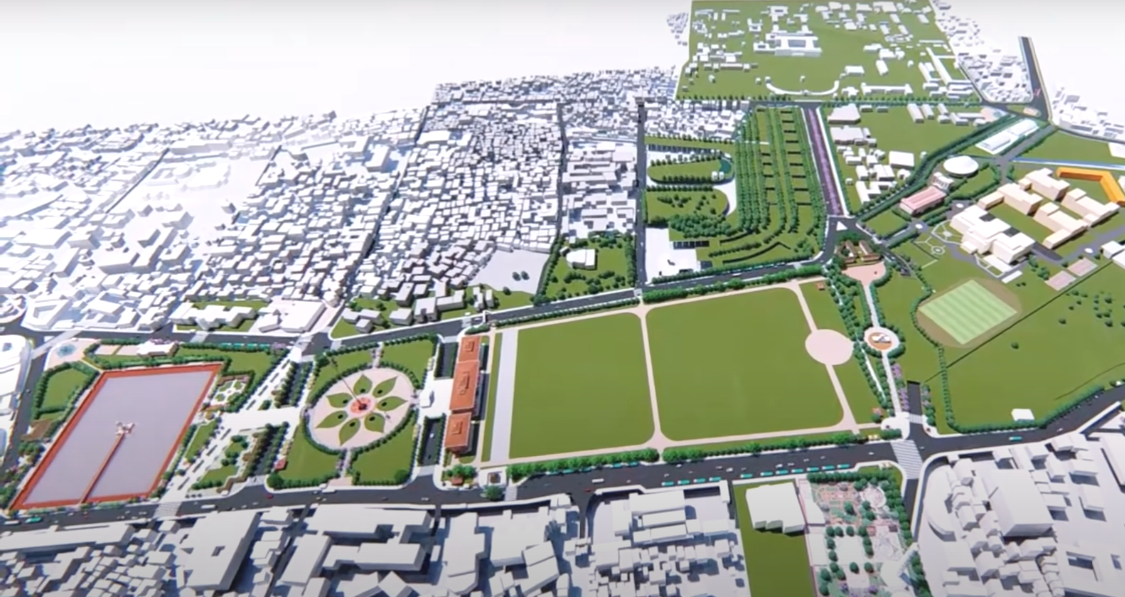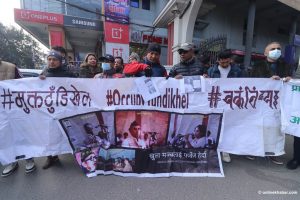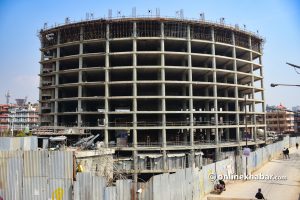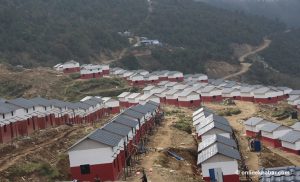One of the highlights of the annual budget plan announced last week for the next year was the Greater Tundikhel project. However, it did not get much attention from the public as the plan had more controversial announcements such as selling stones and pebbles to India at the cost of environment conservation.
On April 25, on the day of the inauguration of the newly constructed Dharahara, the National Reconstruction Authority (NRA) made the master plan of Greater Tundikhel public. As per the plan, the project will cover the area from Narayanhiti Palace to Dasharath Stadium.
However, the detailed project report is yet to be prepared to implement the master plan and the total cost has not been estimated. But still, the NRA has aimed to prepare the DPR in the next five months so as to complete the project in maximum two and a half years.
But, what is the project anyway?
How will the proposed Greater Tundikhel be?
The NRA CEO Sushil Gyewali explains the proposed Greater Tundikhel this way:
“According to this plan, the area from Lainchaur to Kaiser Mahal, from Narayanhiti Durbar to Ranipokhari through Jamal, and then from Ranipokhari to Tundikhel to Dasharath Rangashala will be managed as an open area and further developed as an effective venue for public events.
In the next phase, the plan will cover the public area from Bhrikuti Mandap to Singha Durbar and the Department of Drug Administration in Bijulibazar to the Bagmati Corridor towards UN Park.
Further, pedestrian-friendly structures will be constructed by managing the open spaces in Ratna Park and Shanti Batika located and the open space between Jamal and Ranipokhari.
Except for the Saraswati Sadan, all the structures of the Tr-Chandra Campus will be demolished. A four-story building that will not be taller than Ghantaghar will be constructed on the land behind Ghantaghar.
Discussions have already been held with the Ministry of Home Affairs for the relocation of the Metropolitan Police Office near Ranipokhari and further discussions are underway on where to manage it. After the relocation, the area will also be vacant for public use and an attractive park will be created there.
Likewise, an underpass will be constructed at Ratna Park for the vehicles. Above that will be a well-organised and noise-free path and even benches.
Moving towards Kulamanch, seven lotus leaf-shaped statues indicating seven provinces will be placed there. There will be a flag of Nepal, 8,848-cm high. An underpass will be constructed underground to divert the vehicles coming from Sundhara towards Purano Bus Park. Above that will be a place to use for various cultural events or other meeting events.
A little further on, a building reflecting traditional Nepali art will be built at the Sainik Manch (Army Pavilion). The Nepal Army has already started work on this. Then comes Tundikhel, which will be managed for the use of the Nepal Army parade and general public.
On the other side, Bhrikuti Mandap will be divided into two sections. A plan has been prepared to develop Bhrikuti Mandap, which is about six metres lower than Tundikhel as an exhibition place of Nepali products by managing the open market space at the lower level and developing the upper level as a green park.
Discussions are underway to manage the existing national library there as well. Also, an agreement has been reached with the Social Welfare Council for the project. The area will be elevated up to the level of Tundikhel and the area from there to Singha Durbar will be made green.
The area from Bhadrakali to Dharahara will be developed as a pedestrian path. Bhadrakali and Shahid Gate will be connected with a plot of land. Arrangements will be made for vehicles to cross through the underpass and this expansion will be made stadium-friendly.
The area up to the sports ground in front of the Army Officers Club and the Army Headquarters will also be developed as a public open space. On the base of the area of the Army Officers Club, a parking space for the audience who come to the stadium will be constructed.
In the future, it is planned to connect the area with the Bagmati Corridor from Tripureshwar. But, in the first phase, it will be extended only to the stadium.
Likewise, the Central Jail at Sundhara will be managed and developed as a democratic museum. The Central Jail is being shifted to Bidur in Nuwakot.”
How was the plan made?

According to Gyewali, while laying the foundation stone of Ranipokhari during its reconstruction following the 2015 earthquake, the thought of developing the area from Tundikhel to the stadium as a central park came to him.
He shared his thoughts with the political leadership. The NRA’s steering committee also decided to make a master plan for seven World Heritage sites, six ancient settlements and this area as well.
After that, the NEA leadership continued to change. Gyewali, who was reappointed as the CEO on August 15, 2018, started working to reach a consensus for a greater Tundikhel. The NEA also sought political consensus. Gyewali says that the president and the prime minister have responded positively to this plan.
How does the work move forward?
The tenure of the National Reconstruction Authority is coming to an end on December 25. It is unlikely that the term will be extended. But, who will complete this ambitious plan?
According to Gyewali, although the NRA’s tenure is unlikely to be extended, it will complete the master plan ahead of time. Also, the budget has also been allocated for this.
All levels of government will be involved in the implementation of this plan. Under this, discussions have been held with the mayor of the Kathmandu metropolitan city, the chief minister of the Bagmati provincial government and Prime Minister KP Sharma Oli.
The NRA has already started work on the Tri-Chandra College site as per the plan. Under that, the work of retrofitting Tri-Chandra College has already started. Further, the work of calling tenders for other structures has also already been in progress this year.
Gyewali informs about Rs 1.5 billion has been managed from the Exit Bank of India for the construction of additional infrastructures.
Likewise, the NRA is preparing to hand over the responsibility of construction of the structure from Ranipokhari to Khulamanch to the Kathmandu metropolitan city. Also, the Nepal Army has already taken the responsibility of designing and constructing the structure of Sainik Manch.
The work from Bhrikuti Mandap to the Dasharath Rangashala will be jointly taken care of by the Ministry of Urban Development and the provincial government. Gyewali says that the NRA will not be necessary if a standing committee or any other similar body to monitor the implementation is established after the responsibility of implementation is allocated.



























